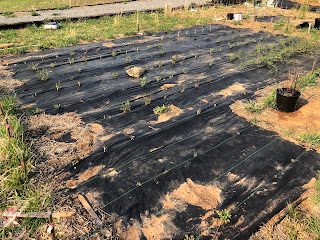I am just getting back to this long-form journal of our little pocket farm now starting it’s third year. The area is starting to recover from Helene, and there’s been a lot of personal stuff going on to distract us so I never came in and filled in those months.
The main thing we did do, and it was a commitment of mine this year, was to get the beds tilled and covered with landscape fabric before the winter rain set in. Guess what, we actually did that! I have the photos to prove it and it looked so nice. Looked.
Before I could brag on it, the valley got several days of big winds and all of the fabric pulled up and flew around. I have my neighbors video to prove that.
So back to square one, and just as the cold weather set in. We got all the fabric back, only a little worse for wear, and it was obvious the pins were just not up to the wind in that valley. We didn’t have the time or health to replace it, and I needed to find the right solution to the wind problem.
And since we are old ladies and the recent extreme cold has us hunkered down at home, we let the field fend for itself til it warmed up. And it has, suddenly, and here we are in a very early spring. So we are back at it, just as I feared, in a kind of panic that we can’t get the new shoots planted in time for spring rainy season - - if we get one!!!
We’ve started harvesting and I posted on IG my very first rods. Kinda paltry in comparison to the lovely bunches (sheaves?) of willow from the more established farms there. Do I have rod envy??? Maybe.
We seem to have about a week of warm sunny weather ahead, and then hopefully a rainy period. Tomorrow we will go for the third trip to harvest the remaining one year plants, and maybe get a few second year varieties harvested too. The usable shoots are being cut in lengths and put in bags on a chilly patio for the moment.
 |
Working indoors while the quantities are still small.
This is Jaune de Falais, the longest rods this yr, 6.5'
|
 |
60 cuttings from Jaune de Falais, including some
very slender - see the pencil in the center for size. |
 |
Miyabeana had the most cuttings - 83! From 11
original plants |
 |
| Check out the variety of colors in the Miyabeana! |
This time, we are going to put down a test length of fabric with 10" nails instead of pins, and a couple of ideas I’ve had to thwart the wind. One idea is to nail down a strip of netting over the edges of the fabric. Netting doesn’t have enough surface area for the wind to catch and might keep the wind from getting under the fabric to pull it up. Another idea is to run a cord taut from nail to nail around the perimeters, giving a continuous pressure at ground level, instead of every few feet. Both of those ideas are reasonable in cost for a large area and far less work than massive use of pins or burying all the edges. We’ve got a little time to see how it holds up before we plant.
There is a benefit to laying down fabric just as we plant, and that is that the willow shoots themselves act as pins across the rows, and adds more resistance to the wind. Our first bed had very few problems with edges being ravelled or pulled up, and I think that’s why that worked.
I hope we can get this all done with our rickety selves creaking from the cold and inaction.
Update 3 days later: We've gotten all of one plot harvested, 9 varieties, about 94 plants, still counting and cutting but it looks like we are getting a good rate of reproduction on most plants, only a few did not produce usable rods and those I'll give another season before I dig them up. The one thing I am sure of - my earlier estimates of quantities were way off. I thought we'd have over 1000 new plants, but a more reasonable guess is about 600. Maybe less. Anyway, I am trying to quickly remap the plots because that update means we only need about half the landscape fabric down! I'll need to get more cover crop seeded but so much less work!! Silver Linings, always.





















